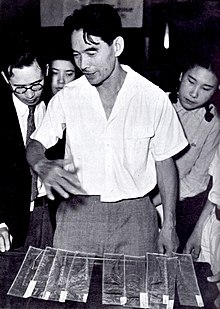Hitoshi Kihara
Hitoshi Kihara | |
|---|---|
木原均 | |
 circa 1950 | |
| Born | October 21, 1893 |
| Died | July 27, 1986 (aged 92) |
| Nationality | Japanese |
| Occupation | Emeritus professor |
| Known for | Wheat genetics |
| Academic background | |
| Alma mater | Kyoto University |
| Thesis | Cytologische und genetische Studien bei wichtigen Getreidearten mit besonderer Rucksicht auf das Verhalten der Chromosomen und die Sterilitat in den Bastarden (1924) |
| Academic work | |
| Discipline | Genetics |
| Sub-discipline | Agriculture |
| Institutions | Kihara Institute for Biological Research |
| Notes | |
This infobox contains information translated from the corresponding Japanese Wikipedia article | |
Hitoshi Kihara (木原 均, Kihara Hitoshi, 21 October 1893 – 27 July 1986) was a Japanese geneticist known for his work on the genetics of wheat.[1]
Biography
Hitoshi Kihara was born on 21 October 1893 in Tokyo, Japan. He graduated from the Faculty of Agriculture, Hokkaido Imperial University and served as a professor at the Faculty of Agriculture, Kyoto University from 1927 to 1956 and the National Institute of Genetics from 1955 to 1969, and also served at Kihara Institute for Biological Research from 1942 to 1984.[1] He was elected a member of the Japan Academy,[2] the United States National Academy of Sciences,[3] the American Academy of Arts and Sciences,[4] and the American Philosophical Society.[5]
Since 1983, the Genetics Society of Japan (GSJ) has awarded the Kihara Prize to researchers who made a considerable achievement in the field of genetics in honor of Hitoshi Kihara who contributed on a global scale to the field of genetics and study of evolution with his research centering on wheat.[6]
In 1985, the Kihara Memorial Yokohama Foundation for the Advancement of Life Sciences was established in Yokohama, to commemorate Hitoshi Kihara and to promote life sciences.[7]
Contribution
At that time, it was mandatory for a Japanese academic to work overseas for a number of years in order to gain admission as members of research faculties. While working in Germany, Hitoshi Kihara studied the genetics of Rumex acetosella and other Sorrel species, and discovered the sex chromosomes.[1] In 1936, he noticed that in wheat seven chromosomes become a pair that performs the lowest gene function, and thus named it genome.[8] The concept of genome extended all over the world and formed the basis for development of biology and genetic engineering.
See also
References
- ^ a b c Crow, James F. (August 1991). "Anecdotal, Historical and Critical Commentaries on Genetics" (PDF). Genetics. 137 (4). Genetics Society of America: 891–894. doi:10.1093/genetics/137.4.891. OCLC 469812548. PMC 1206066. PMID 7982570. Retrieved 22 January 2013.
- ^ "KIHARA, Hitoshi, Deceased members of the Japan Academy". Japan Academy. Retrieved 30 January 2013.
- ^ "H. Kihara". www.nasonline.org. Retrieved 4 October 2022.
- ^ "Hitoshi Kihara". American Academy of Arts & Sciences. Retrieved 4 October 2022.
- ^ "APS Member History". search.amphilsoc.org. Retrieved 4 October 2022.
- ^ "The Kihara Prize and The GSJ Award for Young Scientists". The Genetics Society of Japan. Retrieved 30 January 2013.
- ^ "ABSTRACT OF THE FOUNDATION". Kihara Memorial Yokohama Foundation for the Achievement of Life Sciences. Archived from the original on 2 December 2017. Retrieved 30 January 2013.
- ^ "Hitoshi Kihara, a proponent of the genome concept". The World’s Greatest Japanese. Retrieved 30 January 2013.
External links
- Kihara Memorial Yokohama Foundation for the Advancement of Life Sciences Archived 4 February 2014 at the Wayback Machine
- Kihara Institute for Biological Research, Yokohama City University Archived 29 November 2013 at the Wayback Machine
